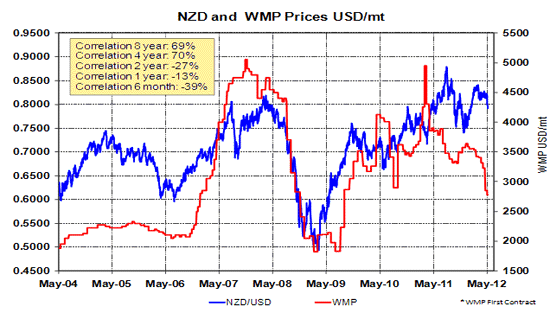
 By Roger J Kerr
By Roger J Kerr
The NZDUSD exchange rate has finally broken out of the constrained band between 0.8100 and 0.8300 it has been trading in since February.
As APRM expected, the break-out has been to the downside with a rapid depreciation to 0.7950 once the key 200-day moving average support at 0.8060 was broken late last week.
Lower commodity prices and a falling Dow Jones Index off the back of a weaker than expected US employment numbers (for the second month in a row) were the factors behind the latest NZ dollar selling.
International wholemilk powder dairy prices have reduced sharply over recent weeks and months due to increased supply from the US and Europe onto the internationally traded market and lower demand from China.
Over recent months while the NZD held above 0.8100 it appeared that the currency had de-coupled from one of its major determinants, wholemilk powder prices.
Capital inflows into NZ Government bonds from Asian central banks and sovereign wealth funds were behind the demand for NZD’s as they diversified away from currency exposures in USD and Euro.
The 4% interest rate yields in New Zealand bonds are also attractive to these investors who see New Zealand as a relative secure and safe economy in a troubled world.
The NZ dollar has certainly held above what you would normally expect due to this investor demand, unrelated to commodity prices. However, we are now seeing the inevitable catch up to lower commodity prices that we were anticipating.
Australia
Adding to the forces driving the NZD/USD exchange rate lower has been the massive U-turn by the Reserve Bank of Australia on their monetary policy settings since January.
They have belatedly realised that the non-mining economy in Australia has been hit very hard by the high AUD value against the USD and relatively high interest rates.
Employment and retail sales figures outside the mining states have been particularly weak and the 0.50% cut in official interest rates by the RBA was a final admission that growth and inflation are lower and the AUD needs to be lowered in value for the sake of the Australian economy. The NZD continues to track the AUD closely against the USD.
New Zealand
New Zealand economic data continues to be a mixed bag, however strong housing, construction and manufacturing sectors are off-setting now falling prices in the agricultural sector.
The general consensus is that the RBNZ will not adjust interest rates upwards until well into 2013.
That view may well change if the NZD/USD rate falls further into the mid 0.7000’s and the domestic demand lifts, lifting inflationary pressure with it.
The RBNZ cannot be complacent on the inflation outlook, as a weaker NZ dollar exchange rate means that prices on imported consumer products will no longer be falling in price to offset and disguise other price increases occurring in the economy, as has been the case for most of the last 12 months.

Looking ahead
APRM still sees rising NZ interest rates in late 2012 and into 2013 as the standout reason why the NZ dollar will be appreciating back up on its own at that time.
Therefore, the current down move in the Kiwi dollar has to be regarded as a prime hedging opportunity for exporters to secure rates in the mid 0.7000’s against the risk of the NZD/USD rate being closer to 0.8500 and higher in 2013.
The prospect of the US Federal Reserve loosening their monetary policy further with a QE3 printing of money has arguably gained some traction after two consecutive months of weaker than expected jobs expansion in the US.
The monthly Non-farm Payrolls numbers are however very prone to subsequent upwards revisions (the March figure revised up from 115,000 to 150,000), so the Fed and the market will be waiting for more confirmation that the US economic recovery has stalled, or not before adjusting monetary policy settings.
APRM”s view is that the US economy is starting to improve under its own steam and does not see any justification for QE3 and further weakness in the US dollar against all currencies.
However, over the next 12 months the US dollar can only be expected to post moderate gains against the Euro, Pound and Japanese Yen.
The NZ dollar forex market ignored the jawboning attempts by the RBNZ Governor and Prime Minister to get the dollar down, however is now justifiably falling on the substantially lower agricultural commodity prices.
--------------------------------------------------------------------------------------------------------------------------------
To subscribe to our daily Currency News and Rate Sheet email, enter your email address here.
--------------------------------------------------------------------------------------------------------------------------------
* Roger J Kerr runs Asia Pacific Risk Management. He specialises in fixed interest securities and is a commentator on economics and markets. More commentary and useful information on fixed interest investing can be found at rogeradvice.com

We welcome your comments below. If you are not already registered, please register to comment
Remember we welcome robust, respectful and insightful debate. We don't welcome abusive or defamatory comments and will de-register those repeatedly making such comments. Our current comment policy is here.